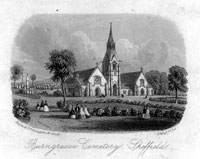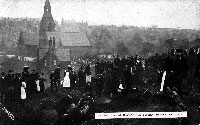Burngreave Cemetery
 A drawing of the cemetery from 1873 showing the two chapels on either side of the bell tower and spire. © Carl Rose  During the coal strike of 1912 people dug for coal in a shallow seam just above the cemetery © Picture Sheffield, Sheffield Libraries In 1861 Burngreave Cemetery was laid out. The architect William Flockton and Sons designed two chapels connected by a central bell turret and spire in a style described as 'geometrical gothic'. One chapel was for Church of England burials and the other for Nonconformists (Methodists, Congregationalists, Quakers, Baptists and others). A plot for Roman Catholic burials was allocated later when the cemetery was extended. A number of interesting graves are located in the cemetery. These include military graves from the Charge of the Light Brigade, the Boer War and the First and Second World Wars. Many local people killed in the First World War Zeppelin Raid are also buried there. Others graves include victims of the Sheffield Flood, people killed in industrial accidents and children who died from diseases prevalent in the late1800s and early 1900s. Today the graveyard is no longer open for new burials. Instead it has become a pleasant green space where people walk dogs or go jogging. It provides a home for a variety of fauna including bats, foxes, butterflies and over 30 species of birds. Many of the trees have been planted as ornamentals but there is also a small patch of natural woodland in the eastern corner of the site. This contains sessile oaks with a carpet of bluebells, considered to be indicators of ancient woodland and possibly the only remaining part of the original Burngreave Wood. The cemetery can be reached from Melrose Road or Burngreave Street, off Burngreave Road, or from Scott Road. Read about the Friends group that support the cemetery in the Community section. |
